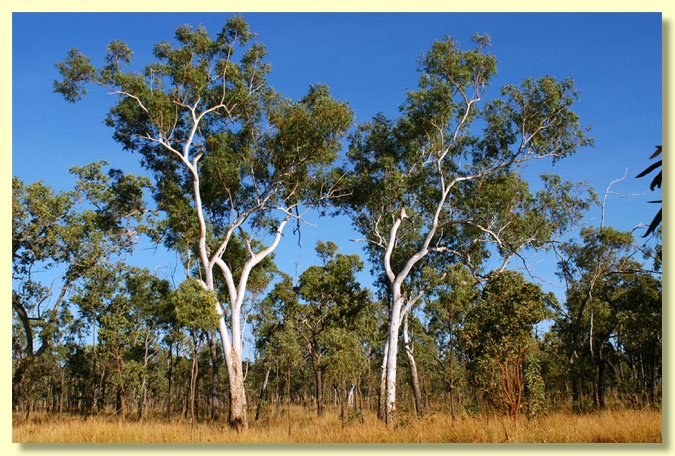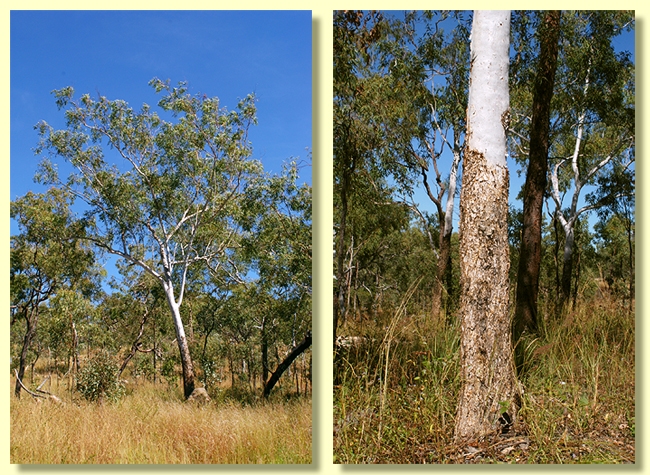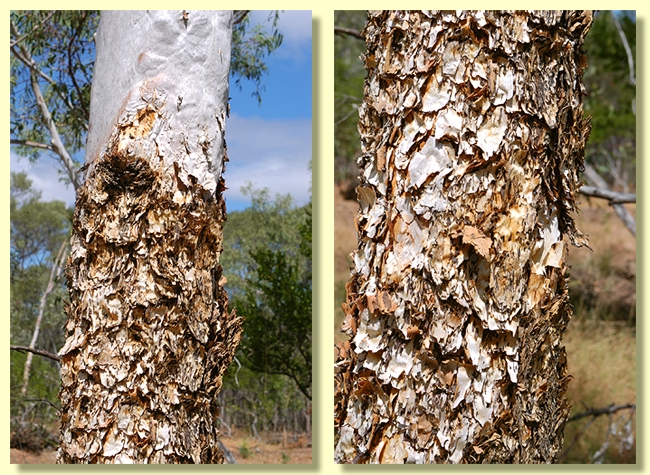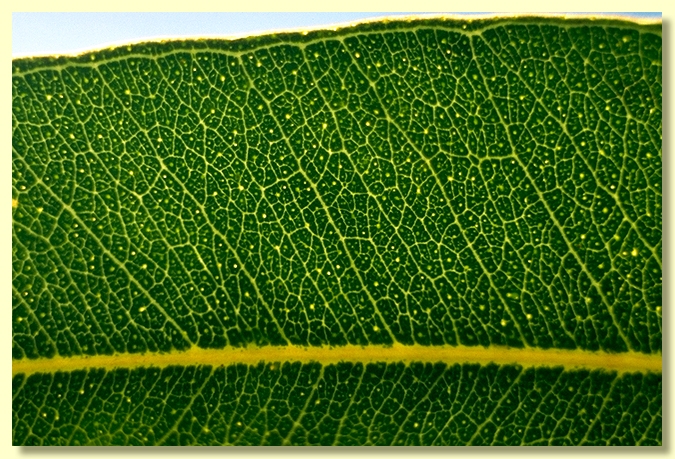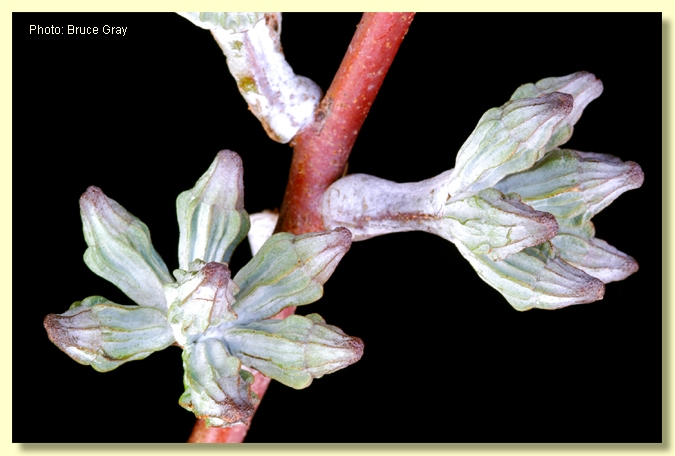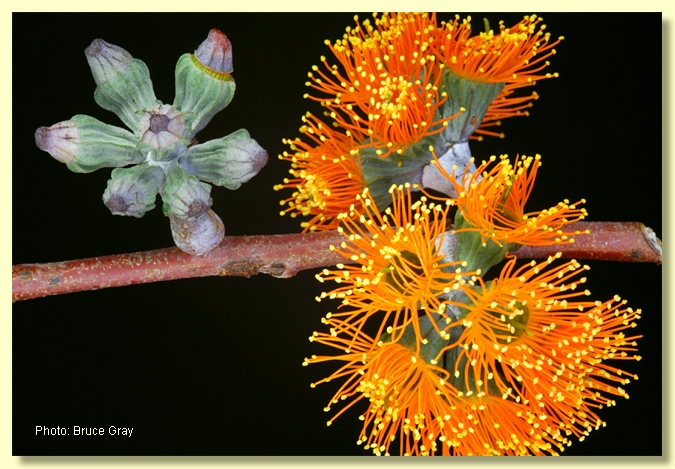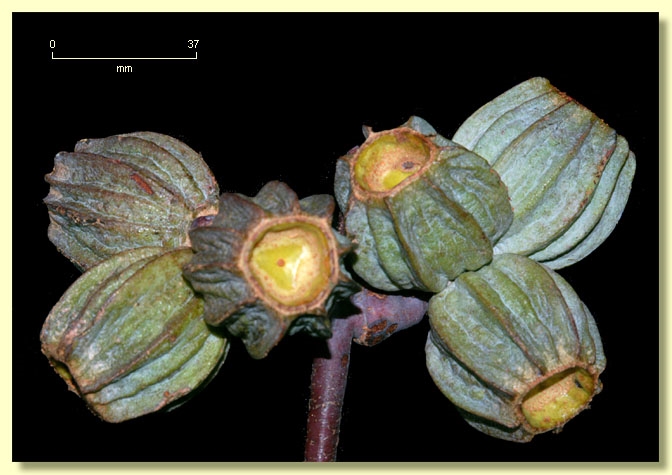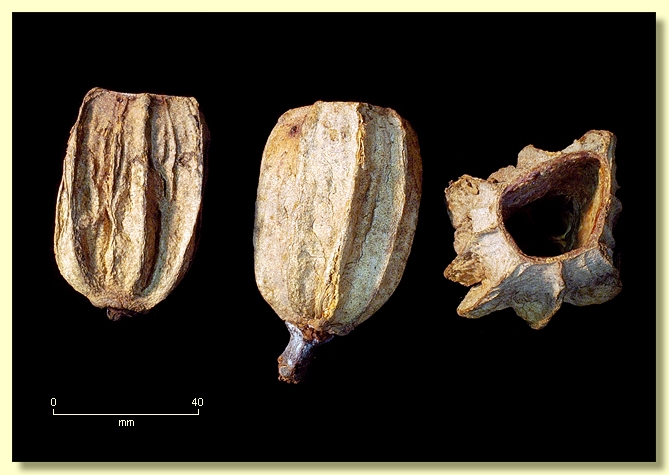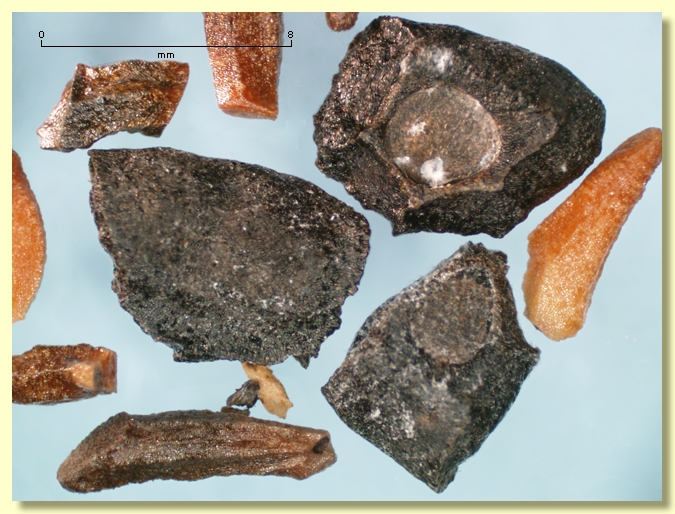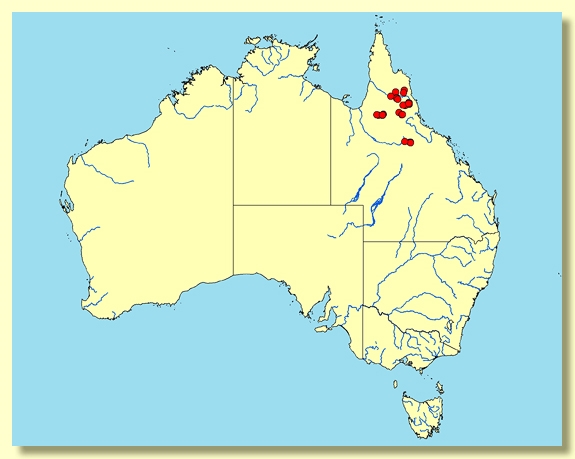Eucalyptus | Eudesmia | Reticulata | Miniatae | Inclinatae
Euclid - Online edition
Eucalyptus chartaboma
Tree to 18 m tall, often much smaller and with several stems. Forming a lignotuber.
Soft fibrous, papery rough bark over the lower trunk, rough bark orange brown to pinkish brown to yellowish brown to white. Upper trunk and large branches with white to pale creamy yellow smooth bark. Branchlets glaucous with oil glands in the pith.
Juvenile growth (coppice or field seedlings to 50 cm): stems rounded in cross-section, hairy; juvenile leaves opposite or alternate, petiolate, ovate, 4–9 cm long, 2–5.5 cm wide, base usually rounded but sometimes truncate or weakly lobed, apex rounded to acute, dull green, with stellate hairs.
Adult leaves alternate petioles 1–2.5 cm long; blade narrowly lanceolate to lanceolate, 8.5–16.5(18.5) cm long, (1)1.3–2.5(3.5) cm wide, base tapering to petiole, discolorous, dull green, rarely grey-green, side-veins at a wider angle than 45° to the midrib, venation dense, intramarginal vein present and very close to the margin, oil glands normally intersectional, sometimes island.
Inflorescence axillary single, peduncles 1.6–3 cm long, buds 7 per umbel, sessile to shortly pedicellate, pedicels 0–0.5 cm long. Mature buds fusiform to ± diamond-shaped (1.6–2.1 cm long, 0.8–1.1 cm wide), glaucous, calyx fused to the corolla and evident as 4 small teeth at the apex of the bud, hypanthium longitudinally striated or ribbed, operculum conical, stamens inflexed, anthers oblong, versatile, dorsifixed, dehiscing by longitudinal slits (non-confluent), style long, hooked or bent beneath the apex of the bud, stigma tapered, locules usually 3, the ovules usually arranged in 4 or sometimes 6 distinct vertical rows on the placentae. Flowers orange.
Fruit sessile, truncate-ovoid to slightly urceolate, longitudinally ribbed, 3–7.5 cm long, 3–6.5 cm wide, glaucous, disc vertically to obliquely descending, valves 3, enclosed.
Seeds dull dark grey to black, ± flattened to obliquely pyramidal to ± cuboid, 5–8 mm long, ventral surfaced ribbed, dorsal surface smooth, hilum ventral.
Cultivated seedlings (measured at node 10): not seen
Flowering has been recorded in January, February, March and April.
Eucalyptus chartaboma is a medium-sized tree, of scattered occurrence in north Queensland from the Croydon area, east to near the Einasleigh and Mount Garnet, then north to the Maitland Downs area on the southern Cape York Peninsula, with a disjunct population north-west of Torrens Creek. It is characterised by its yellow-brown to pink-brown rough, papery or fibrous bark on the lower trunk and the smooth, white to creamy yellow bark on the upper trunk and branches, the discolorous, narrowly lanceolate adult leaves, the glaucous buds, the bright orange filaments of the flower and the large, glaucous, ribbed, truncate-ovoid fruit.
Eucalyptus chartaboma belongs to the taxonomically complex Eucalyptus subgenus Eudesmia, and is included in section Reticulatae series Miniatae subseries Inclinatae characterised by having the calyx fused to the corolla and evident as four small teeth at the apex of the bud, hairy seedlings, adult leaf reticulation relatively dense, buds with a long style and bright orange flowers.
Within the subseries, it is morphologically closest to E. gigantangion, from the Kakadu National Park area of the Top End of the Northern Territory, and to E. miniata, a common species right across the top of Australia from the Kimberley to just across the Queensland border. E. miniata can be distinguished by its broader adult leaves (adult leaves in E. miniata 2–4.5 cm wide and in E. chartaboma 1–2.5 cm wide). E. gigantangion is weakly distinguished from E. chartaboma by its non-glaucous branchlets, buds and fruit (E. chartaboma glaucous).
E. phoenicea and E. ceracea, two other members of the subseries Inclinatae, are relatively close to E. chartaboma. E. phoenicea can be distinguished by normally having more than 15 buds to each umbel and by having narrower cylindrical to urn-shaped fruit to 1.3 cm wide. (E. chartaboma has seven-budded umbels and large fruit, always wider than 3 cm.) E. ceracea can be distinguished by consistently having a mature crown of glaucous, ovate juvenile leaves.
Eucalyptus chartaboma: Greek charte, of paper and bomos, base, referring to the papery persistent rough bark on the base of the trunk.

